
Sofia is the capital and largest city of Bulgaria. It is situated in the Sofia Valley at the foot of the Vitosha mountain, in the western part of the country. The city is built west of the Iskar river and has many mineral springs, such as the Sofia Central Mineral Baths. It has a humid continental climate. Being in the centre of the Balkans, it is midway between the Black Sea and the Adriatic Sea and closest to the Aegean Sea.
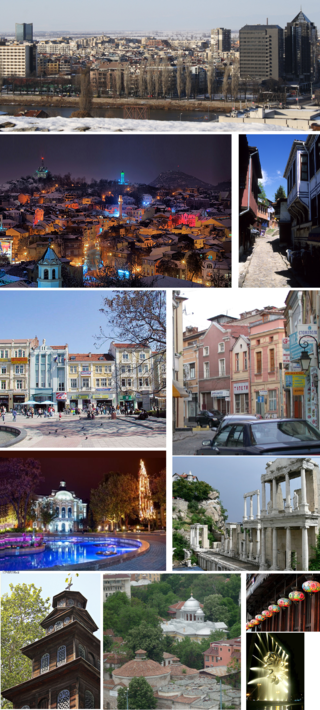
Plovdiv (Bulgarian: Пловдив, pronounced[ˈpɫɔvdif] is the second-largest city in Bulgaria, 93 miles southeast of the capital Sofia. It had a population of 371,536 as of 2024 and 675,000 in the greater metropolitan area. Plovdiv is a cultural hub in Bulgaria and was the European Capital of Culture in 1999 and 2019. The city is an important economic, transport, cultural, and educational centre. Plovdiv joined the UNESCO Global Network of Learning Cities in 2016.

Blagoevgrad is а town in Southwestern Bulgaria, the administrative centre of Blagoevgrad Municipality and of Blagoevgrad Province. With a population of almost 70,000 inhabitants, it is the economic and cultural centre of Southwestern Bulgaria. It is located in the valley of the Struma River at the foot of the Rila Mountains, 101 kilometres south of Sofia, close to the border with North Macedonia.
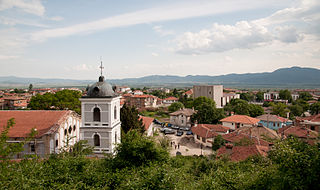
Sopot is a Bulgarian town situated in the fertile sub-Balkan mountain valley of Karlovo, immediately below the steep southern slopes of the Troyan Balkan Mountain. Sopot is part of Plovdiv Province and is the administrative centre of a municipality with the same name.

Tryavna is a town in central Bulgaria, situated in the northern slopes of the Balkan range, on the Tryavna river valley, near Gabrovo. It is famous for its textile industry and typical National Revival architecture, featuring 140 cultural monuments, must, and expositions. Tryavna is the birthplace of Bulgarian writer Pencho Slaveykov and revolutionary Angel Kanchev.
Tran is a small town in Tran Municipality, Pernik Province, western Bulgaria. It is 27 km (17 mi) from Breznik and 15 km (9.3 mi) from the border with Serbia.

Velingrad is a town in Pazardzhik Province, Southern Bulgaria, located at the western end of Chepino Valley, part of the Rhodope Mountains. It is the administrative center of the homonymous Velingrad Municipality and one of the most popular Bulgarian balneological resorts. The town has a population of 22,602 inhabitants according to the 2011 census of Velingrad.

Poduyane or Poduene is a residential complex and a district of Sofia, the capital of Bulgaria with 85,996 inhabitants. It is located in the northeastern outskirts of the city and is divided into microregions. Poduyane consists of the neighbourhoods Suhata Reka, Hadzhi Dimitar, Poduyane, Stefan Karadzha, Levski, Levski-G, Levski-V. A former village, it was incoroparted in 1895. The district's holiday is celebrated on 1 June.
Kostinbrod is a town in western Bulgaria. It is the seat of Kostinbrod Municipality. It is located 15 km west of the capital city of Sofia. It is located on two important transport corridors: Lom — Sofia — Thessaloniki and Sofia — Belgrade. The international railway line to Western Europe passes through the municipality, with a train stop at Kostinbrod Station.
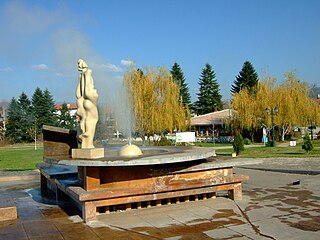
Sapareva Banya is a town in southwestern Bulgaria, part of Kyustendil Province. As Ancient Germania, a former bishopric, it is a Latin Catholic titular see.

Kostenets is a village in the Sofia Province southwestern Bulgaria, located in the Kostenets Municipality. As of the 2000 census, the village had a total population of 4,201. It ranks 14th by population of all Bulgarian villages.

The Central Mineral Baths is a landmark in the city center of Sofia, the capital of Bulgaria, a city known for the mineral springs in the area. It was built in the early 20th century near the former Turkish bath and was used as the city's public baths until 1986.
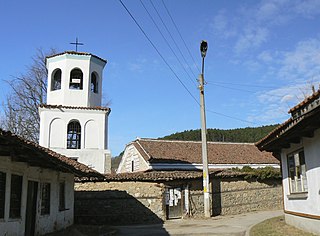
Poibrene is a village in the Panagyurishte municipality, western Bulgaria. It is located 18 km (11 mi) west of the town and has 850 inhabitants. The large dam Topolnitsa is 1 km west of the village. Several monuments there commemorate participants in the April Uprising. Due to the dam, the baths and the clear natural environment, many citizens of Panagyurishte have summer houses in or near the village.

Pavel Banya is a small town in Stara Zagora Province, South-central Bulgaria, located between the towns of Kalofer and Kazanlak. It is the administrative centre of the homonymous Pavel Banya Municipality. As of December 2009, the town had a population of 2,918. The place is famous for its mineral springs.
Vitosha is one of the 24 districts of Sofia, situated in the southern parts of the City on the foot of the Vitosha mountain. As of 2006 it has 42,953 inhabitants. The district includes 7 neighbourhoods: Boyana, Simeonovo, Dragalevtsi, Pavlovo, Buxton, Manastirski Livadi, and Knyazhevo as well as two villages Vladaya and Marchaevo. It is among the richest and greenest districts in Sofia and Bulgaria with many beautiful residences, houses, villas and residential complexes.

Pancharevo is a resort village and district located on the outskirts of Sofia close to Vitosha, Lozenska and Plana mountains and occupies the southeastern part of the Capital Municipality.As of 2011 the village has 3,433 inhabitants, but the district has about 28,000 inhabitants. It is the largest region in Sofia with a total area of 3,647 km2 (1,408 sq mi). It includes the largest artificial lake in Bulgaria Lake Pancharevo, also as Iskar Reservoir and Pasarel Reservoir, located one above the other. The districts consists of 10 villages, and Pancharevo is the municipal seat:

Joseph Sebastian Oberbauer was an Austrian and Bulgarian painter and engineer.
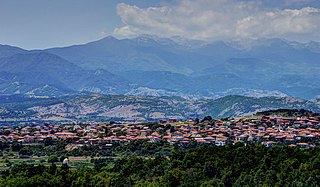
Ognyanovo is a resort village with thermal mineral water springs in Garmen Municipality, in Blagoevgrad Province, Bulgaria.
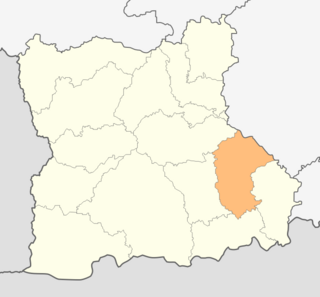
Garmen Municipality is situated in the southeastern part of Blagoevgrad Province in Southwestern Bulgaria. It is a rural municipality, composed of 16 villages. The administrative center is the village of Garmen, but the most populated village is Ribnovo. The municipality lies in the western part of the Rhodope mountains.

Gorna Banya is a neighbourhood in Sofia, the capital city of Bulgaria. It is one of the city's oldest villa zones. The town is part of Sofia's Ovcha Kupel administrative district. It is located in the southwestern part of the capital and borders Knyazhevo to the south and Ovcha Kupel to the northeast.



















